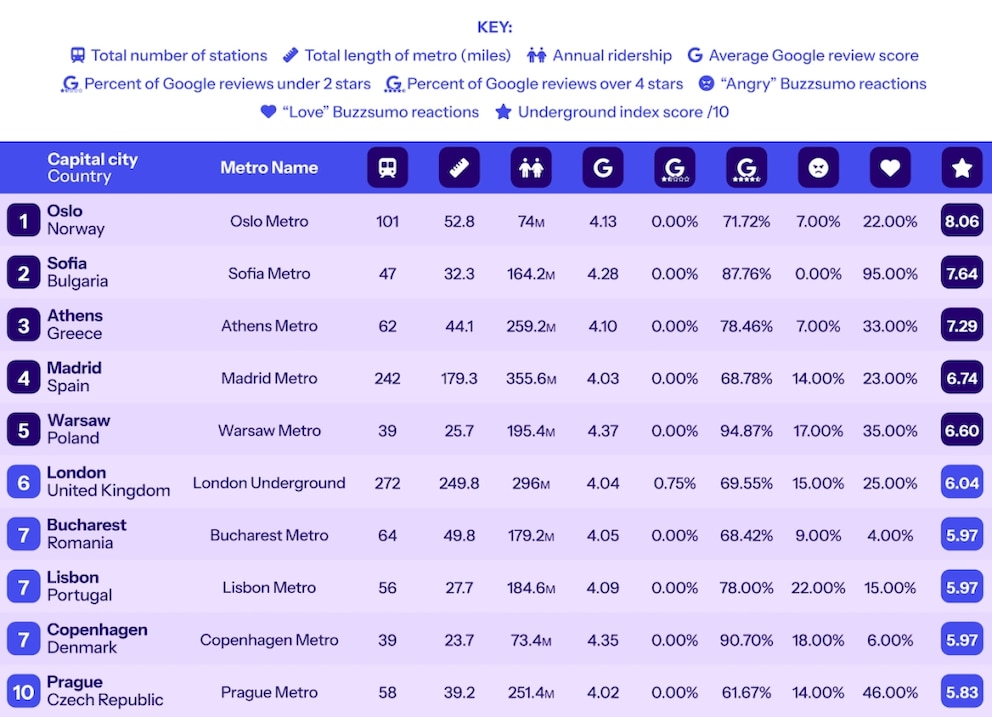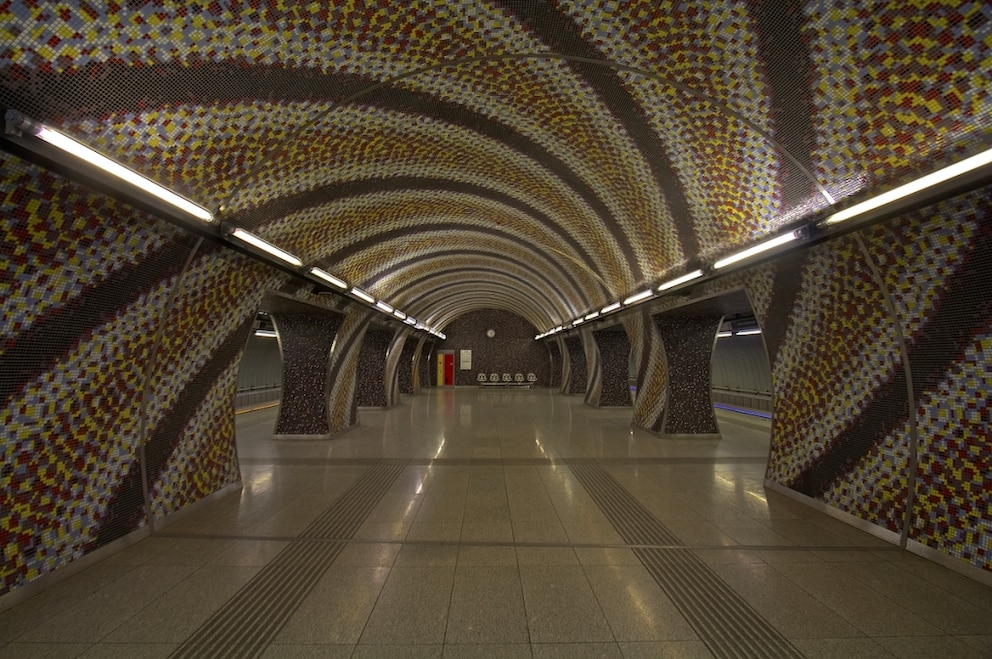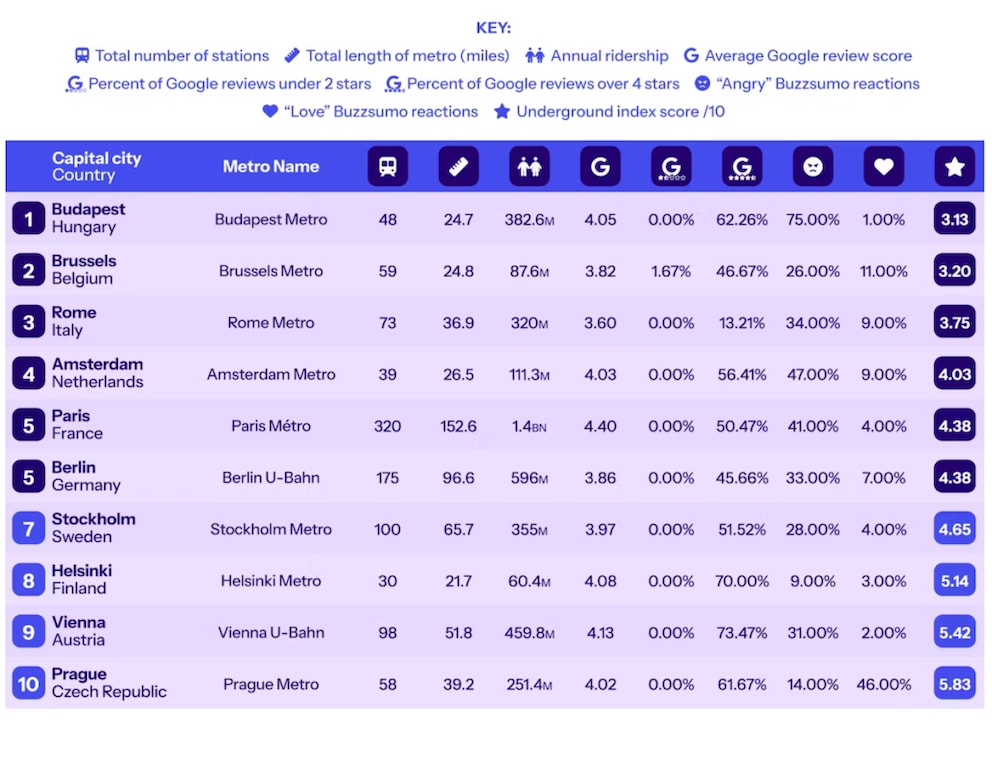October 12, 2024, 4:43 pm | Read time: 4 minutes
On a city trip, especially in larger cities, it’s great if you can get from A to B quickly and easily – thanks to a well-functioning subway network, for example. A recent analysis shows in which European capitals this is particularly the case – and where it is probably better to do without the subway.
For its “Subway Index”, the company “Bounce“, a provider of luggage storage, compared the subway networks of capital cities in Europe in terms of various factors. The evaluations included the number of subway stations in each city and the total kilometers of the subway network. Other factors included the number of annual passengers, the average Google ratings of all stations, and the number of positive and negative reactions in connection with media reports about the respective metro networks.
Overview
The cities in Europe with the best subway networks
1st place: Oslo, Norway
The capital city in Europe with the best metro network is Oslo, according to Bounce’s analysis. There are 101 metro stations spread across the city, the network spans 85 kilometers and covers all 15 districts. The Oslo metro scores with an above-average number of positive reviews on Google and comparatively many positive reactions in the media. It is described as well organized and easy to get around.
Bounce’s analysis adds: “The metro in Oslo consists of five separate lines, with another one currently under construction. All five lines run through Oslo’s central tunnel, so travelers can access each line via the tunnel’s six stations.”

2nd place: Sofia, Bulgaria
Second place in the ranking of European capitals with the best metro network goes to the Bulgarian capital Sofia. The city’s metro system stretches over 52 kilometers of tracks and is accessible via 47 stations, including one at Sofia Airport. This makes getting to Sofia particularly straightforward. According to the many positive reviews on Google, there is plenty of English signage in the Sofia metro, including payment instructions, making it easy to understand and accessible for foreign visitors.
3rd place: Athens, Greece
The Athens Metro has 62 stations over a distance of 71 kilometers. Like Sofia, the Athens Metro offers a direct connection to the airport and allows travelers to reach the city center quickly and cheaply. The average Google rating for all metro stations in the city is 4.10 out of five, and they are generally considered to be in good condition.
Like Sofia, the Athens metro offers a direct connection to the airport and allows travelers to reach the city center with cheap, fast, and regular public transport. The metro also connects the city’s busy port area, from which you can travel by ferry to many Greek island destinations, such as Crete, Rhodes, Naxos, and Mykonos.
All rankings at a glance

The capital cities in Europe with the worst subway networks
1st place: Budapest, Hungary
The Budapest Metro, or “Budapesti Metró” in Hungarian, is the worst-rated metro system in the Bounce study. With 48 stations on only 40 kilometers of track, the metro network is relatively small, but with over 382 million passengers per year, it has a disproportionately high number of riders. The average ratings on Google are okay, but the Budapest metro receives many negative comments in media reports.

2nd place: Brussels, Belgium
The Brussels metro is the second-worst in Bounce’s “metro index”, scoring only slightly better than Budapest. It has 59 stations on a route of 40 kilometers, which covers the entire urban area of Brussels. Compared to the systems of other cities, however, the Brussels metro is relatively unpopular – both in terms of the number of negative comments online and in terms of Google ratings.
3rd place: Rome, Italy
With 73 stations and almost 60 kilometers of track, the metro in Rome is much more extensive than those in Budapest and Brussels. Travelers are also well-connected to surrounding areas, including Rome Fiumicino Airport, via a system of commuter trains. Nevertheless, the average Google rating for Rome’s metro stations is just 3.60 out of five, with only around 13.21 percent of stations receiving a rating of four or more points. Furthermore, 34 percent of online reactions to news articles about the Roman metro are “angry”. Only nine percent of reactions are positive.
The German capital Berlin, together with Paris, landed in fifth place on Bounce’s negative list.
All rankings at a glance


Hong Kong Is the City with the Best Public Transporta in the World

The World’s Unfriendliest City Is in Germany

This is the worst train station in Germany
Criticism of the methodology
Bounce’s comparison certainly provides an initial overview of the quality of the metro networks in Europe’s capital cities. From TRAVELBOOK’s point of view, more official data and statistics would have to be used to paint a more comprehensive and detailed picture. These include train punctuality, cleanliness, and crime.

